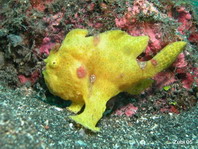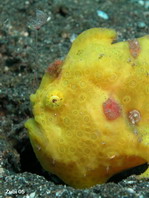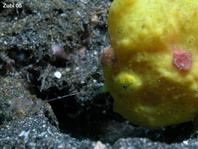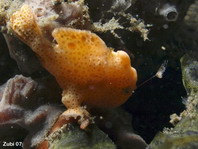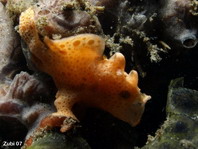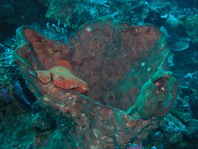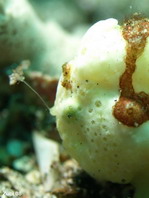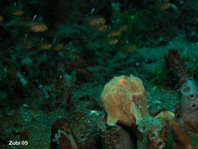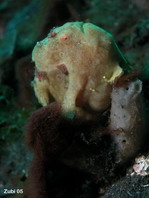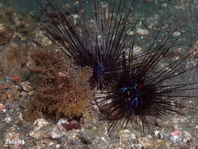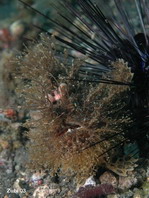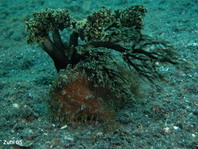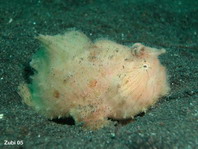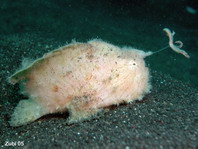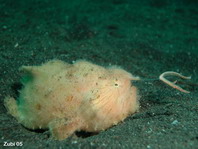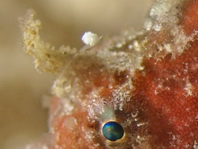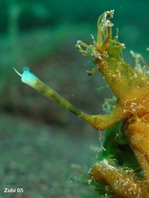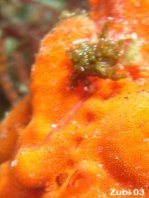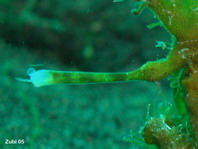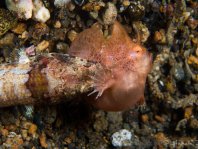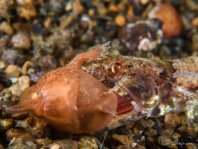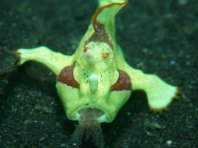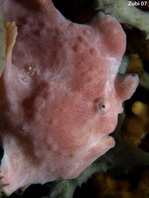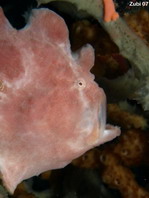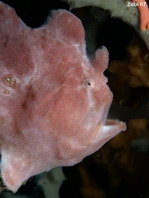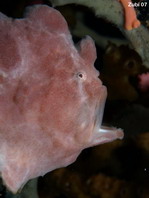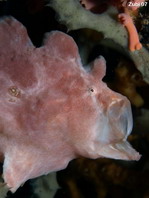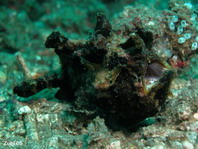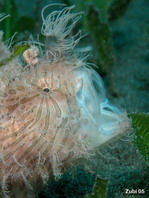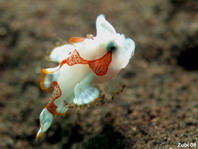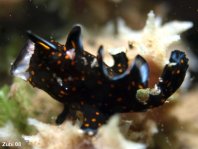
 www.frogfish.ch
www.frogfish.ch

Feeding behavior
Aggressive Mimicry
- Luring prey - Gape
and Suck
Print version frogfish
behavior - Diese Seite
in Deutsch
![]()
Aggressive Mimicry
The most interesting aspect of the frogfish, apart from his prefect camouflage is the way he attracts his prey. Other fish lie in wait until the prey swims close to their mouth (lie-in-wait predation), but the frogfish (or anglerfish) lures the prey (fish, crustaceans) actively to where it can strike. The lure mimics food animals like worms, small shrimps or small fish. The prey approaches to catch the lure and then is engulfed by the waiting frogfish (see a video). This strategy is called aggressive mimicry.
|
|
|
|
|
|
|
|
|
|
|
|
Of course not all prey is attracted by the lure. A more passive approach is the excellent camouflage of the frogfishes. Many animals just mistake a frogfish for a sponge, come too close and are swallowed. I have actually seen on various occasions, how small gobies flittered over the body of a frogfish sitting in a sponge, without being aware of the danger of getting eaten (image).
Other fishes will perceive the camouflaged frogfish as perfect shelter and approach too close. Frogfishes often look like algae covered rocks. In coral reefs there isn't really a plentiful supply of algae for herbivore fishes. These fishes will approach a frogfish because they perceive a good feeding ground and are then caught. Because no herbivore fishes can eat plants surrounding the frogfish (they all get caught) these plants will grow extensively and even more fishes are attracted to the ambush site.
The frogfish sometimes also actively stalks prey, I have seen a frogfish (Antennarius striatus) trying to catch a small flounder by slowly sneaking towards it. It was trying to get the flounder into striking distance. The strike zone is about one frogfish body length. Click on thumbnail for enlargement.
|
|
|
![]()
Luring prey
Click here for videos of frogfishes luring
Frogfishes mainly eat fishes and crustaceans (shrimps and crabs). They can swallow items of prey that are twice as large as them (see a video). Luring techniques vary depending on the surrounding the frogfish lives in. A frogfish (for example Antennarius striatus) living mainly on sand often has a lure that reaches close to the ground, so it can move the lure at the entrances of burrows or entice benthic animals like flounders to come closer. A frogfish living exposed on sponges or corals (for example Antennarius commerson) will lure more often above its head and might have a longish lure. A frogfish living hidden in crevices (for example Antennatus nummifer) often is small and has a small lure, more like a white ball and will stretch it in front of its head or just above.
Each frogfish species moves the rod (illicium) with its lure (esca) in a special pattern to attract the attention of potential prey. For example the warty frogfish (Antennarius maculatus) moves its lure in wavy lines either above the head or directly in front of the mouth close to the ground, the lure is doing a circle. The giant frogfish (Antennarius commerson) is moving its lure up and down in jerky movements. A study in luring behavior by S. Michael also showed, that a frogfish can vary its angling technique. A coinbearing frogfish (Antennatus nummifer) he observed used three different luring patterns - lifting the lure and vibrating the esca, holding the lure still in front of the mouth and throwing the angel rapidly back and forward.
The frogfish on the following photos all have long lures. Click on thumbnail for enlargement.
The 6 photos below show the Painted Frogfish (Antennarius pictus) moving its lure |
||
The pictures (below) to the left and right were taken at the same dive site but a year apart. They are from two different species (different lure!) but show the same behavior. |
||
|
|
|
|
|
|
Frogfishes even lure in the dark. Although the lure and esca can not be seen during night, the potential prey can feel the vibrations which are transmitted through the water and attack what seems to be an incautious animal.
Frogfishes also employ chemical attractants. This is of importance to frogfish that forage at night like the hairy frogfish (Antennarius striatus). This frogfish also enlarges his esca by 35% when actively luring. The hairy frogfish, a juvenile, about 9cm large, on the following 9 photos (also possible to see as a short video) was walking about and luring during about 10 minutes, checking out several goby burrows but with no success. During some time it stretched the lure out in front while walking, then again it was moving the lure over its head in complicated patterns. It was interesting to observe the lure, which made wavy movements, then again was rolled up and nearly hidden. Click on thumbnail for enlargement.
 |
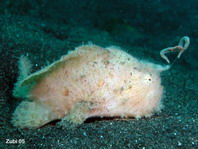 |
|
 |
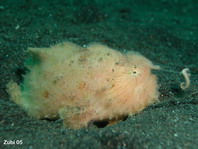 |
|
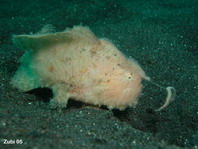 |
 |
Small frogfishes often prefer shallow water and live hidden in crevices between corals and among rubble. Hiding in such a way they avoid being preyed on by larger fishes. Smaller frogfishes probably don't use their lures as much as larger frogfishes to attract prey. Several of these frogfishes have very small lures (like Antennatus coccineus) or one that is nearly not discernable (like Antennatus tuberosus). The following photos show frogfishes with short rods and small lures (a small white dot). The rod is stretched out in front and not moved much. Click on thumbnail for enlargement.
|
|
|
Because the esca acts as a bait it is apparently highly susceptible to loss or damage by attacks or nibbling of potential prey as well as predators. Therefore some frogfish (for example Antennarius pauciradiatus or Antennarius randalli) have a pocket-like aperture formed by the membrane between the second and third dorsal spine which is used to protect the esca. Frogfish can regenerate their lure but might undergo a time of fasting until completion. It seems to take about 4 to 6 months to fully regenerate a lure.
Sometimes a predator also catches a frogfish. As the photos below show, the frogfish is inflating its body by swallowing water, so it is quite difficult for the predator (here a lizardfish) to swallow it. The photographer Stephane Bailliez wrote: I stayed around for more than 30mins while the lizardfish was stuck with this annoying prey. It tried a couple of times to do a quick release / catch in order to rotate it and thus tried different angles.
|
|
|
|
|
|
|
|
|
There is a group of frogfish species, which have no or a much reduced lure. The newly (2008) discovered frogfish species Histiophryne psychedelica (Ambon Frogfish) seems to block off the entrance to holes or crevices and thus entraps its prey inside (reference). It would be interesting to investigate if other nearly rodless frogfishes like Histiophryne bougainvilli or Histiophryne cryptacanthus also employ a similar behavior of predation.
Frogfishes also have a small small white skin flap or knob just above the mouth. I have observed this flap on several frogfish species, it is not always very prominent, but mostly of a white color. I haven't found any references to it in literature. I think, this is probably an additional enticement for small animals to go near the mouth!
|
|
|
|
|
The Deep-sea anglerfishes even have a glowing lure (bioluminescence produced by symbiotic bacteria) decorated with filaments or branches that also glow in the dark. These frogfish have a massive mouth and razor-sharp teeth. The lure can be four to five times longer than the fish itself and some anglerfishes of the family Linophrynidae (Leftvents) even have barbels on their chin that also generate light and look like a hanging basket.
![]()
Gape and Suck

Hairy Frogfish (Antennarius striatus) has caught a flounder but is unable to swallow the fish
because it is too large. After about 45 minutes the frogfish spat the
flounder out, it was dead by then. Tropical frogfishes have no teeth,
so they can't tear a fish into smaller pieces. Either swallow whole ar
not at all.
Copyright Matthew
Oldfield - more images of this frogfish (Flickr)
|
|
|
|
|
|
|
|
|
|
|
|
|
|
|
When feeding, the frogfish expand the oral cavity. The lower jaw is lowered and the upper jaw is expanded. They engulf their prey with a reflex that sucks it in by creating suction pressure inside the mouth (increase up to 12 times in volume by expansion of the oral cavity). This is the fastest "gape and suck" of any fish, it takes only a six-thousandths of a second, which is faster than a scorpionfish or a stonefish (15 msec).

Frogfish hunting: luring, opening mouth, engulf the prey
They can actually catch a fish out of a school without the other fish noticing the disappearance. A frogfish will easily swallow prey that is larger than itself. It doesn't have teeth, because the prey is swallowed whole and not cut into pieces by the teeth. Click on thumbnail for enlargement.
|
|
|
|
|
|
|
|
|
|
|
|
|
|
|
The frogfish is sometimes seen, opening its mouth and yawning. But only on two occasions I have seen how a frogfish actually eats its prey (see a video). Actually everything happened so fast, that all I really saw was the shrimp in front of the frogfish and then the frogfish moved and the next thing I realized the shrimp was gone and the frogfish made swallowing movements. No wonder that the frogfish can eat fishes out of a school without the other fishes noticing!
|
|
|
|
|
|
Even tiny frogfishes (the red fish on the pictures above is about 4mm long) open their mouth to "yawn".
What goes in must come out....
|
|
|
|
|
![]()
DVD
My recommendation: A great DVD with coverage of the uncommon animals living in the Lembeh strait by Shark Bay Films "The Critter Trilogy" (John Boyle). Filmed entirely in Indonesia's Lembeh Strait in open water. Great coverage of frogfishes feeding and much more! Sold by www.electricsky.com
